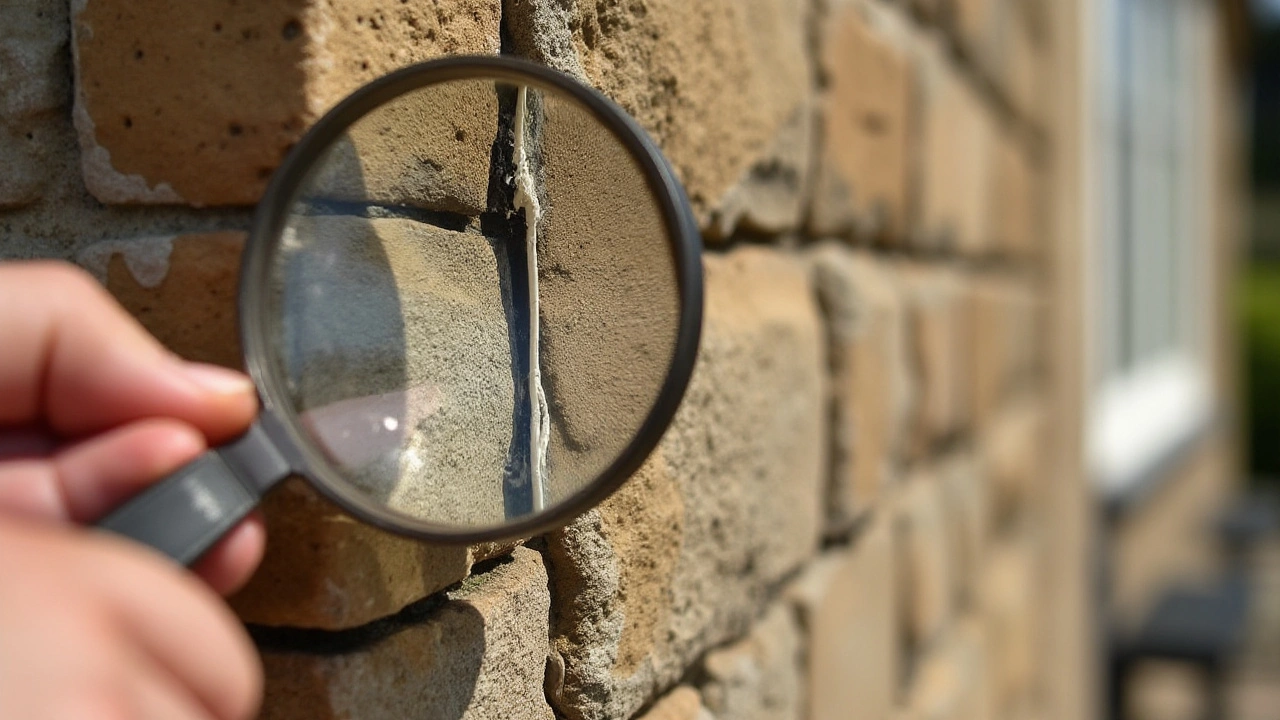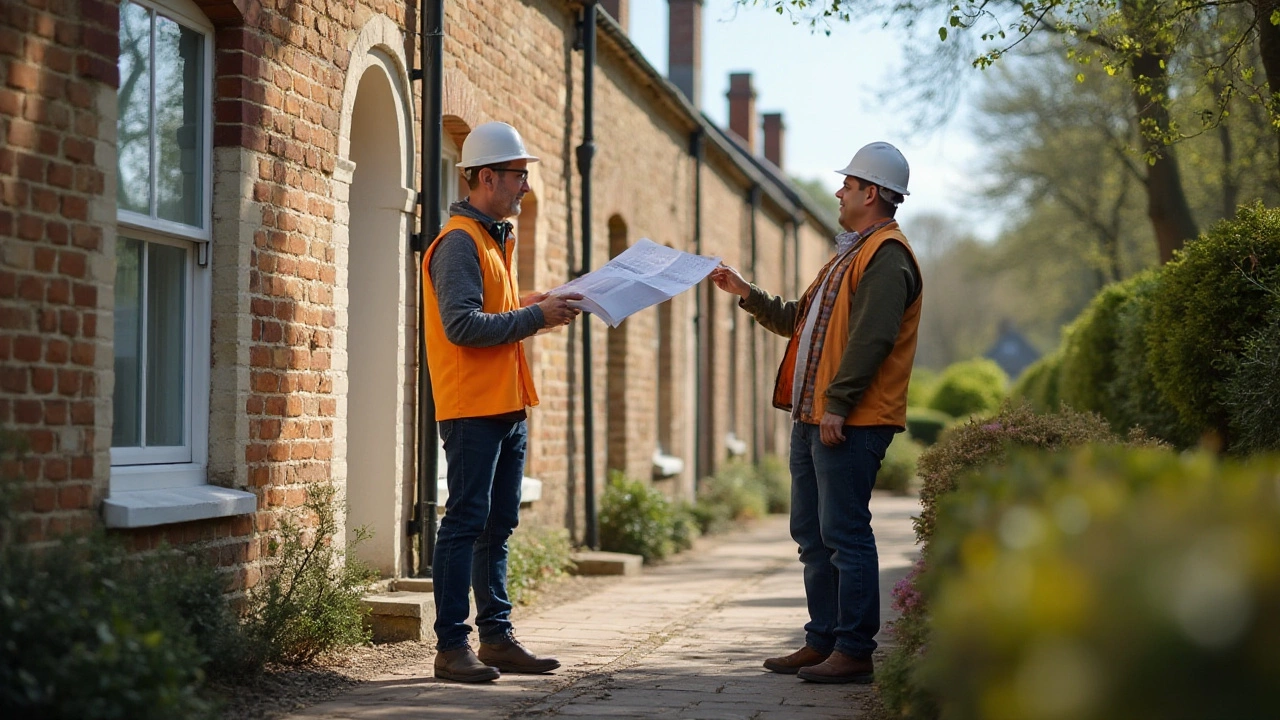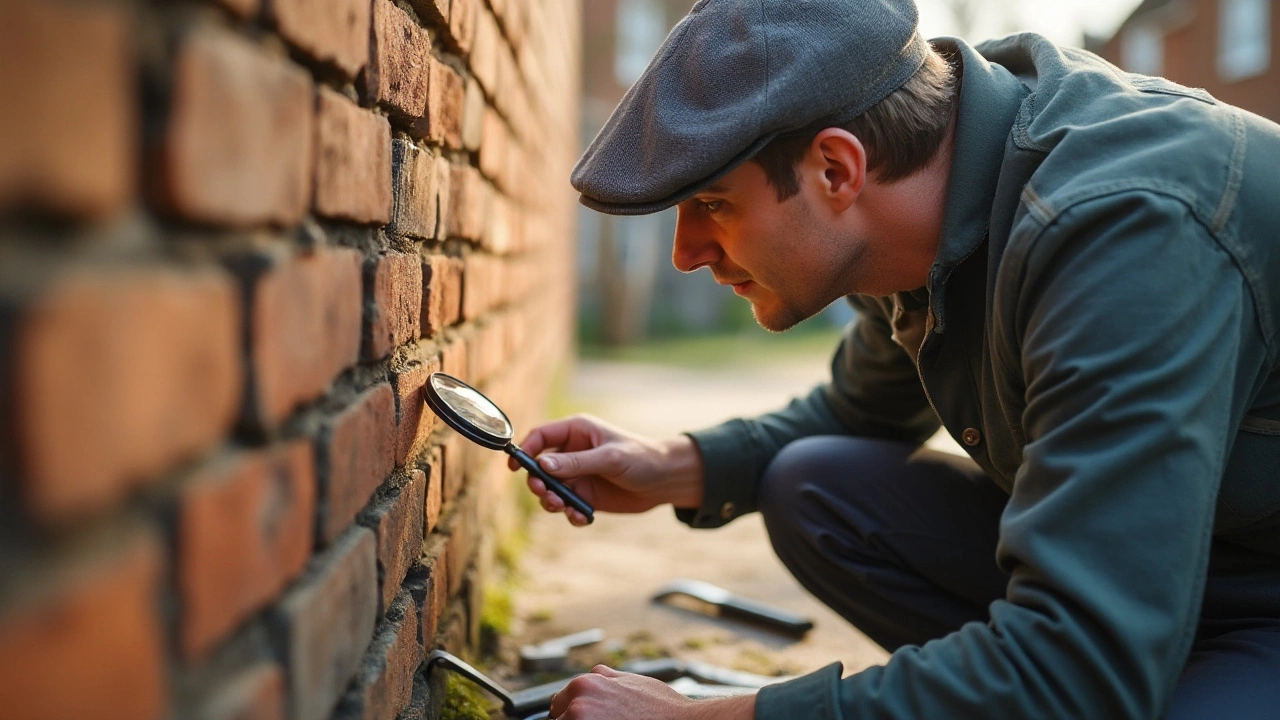When gazing at the complex web of veins a tree leaf supports, one often forgets that a house’s foundation can exhibit a similar pattern, though far less poetic. Foundation cracks are a reality for many homes, whether new or old. While some might look like mere cosmetic flaws, others could spell trouble down the line.
Understanding the difference between harmless and potentially harmful foundation cracks is key to maintaining a safe and sturdy structure. Different types of cracks can tell different stories— from the harmless hairline variety to those that might suggest a more profound underlying issue affecting the structural integrity of your home.
- Understanding Foundation Cracks
- Common Types of Foundation Cracks
- Signs a Crack is Serious
- The Impact of Serious Cracks
- Preventing Foundation Cracks
- Seeking Professional Help
Understanding Foundation Cracks
Understanding the nature of foundation cracks is fundamental to protecting the structural integrity of your home. Foundation cracks often vary widely in appearance, origin, and seriousness, making it essential to pinpoint their causes and implications. When you know what you are dealing with, it becomes easier to determine whether a crack is a minor aesthetic issue or a serious complication that needs immediate attention.
Foundation cracks often emerge due to natural settling, shifting soil, or unforeseen environmental impacts. The most common of these are hairline cracks, which typically resemble thin lines drawn with a pencil across your walls. These can appear when the concrete undergoes normal settling or minor shrinkage as it cures and doesn't usually pose a threat. However, as the world around them evolves, they might change too, and that’s when monitoring comes into play.
Environmental factors like heavy rainfall, extended drought periods, or even uneven moisture levels in the soil surrounding your home can lead to different sorts of cracking. For instance, when the soil underneath your home’s foundation expands during rainy seasons and shrinks in dry conditions, it might result in horizontal cracks that can compromise a foundation’s stability. Vertical cracks are usually less alarming but require attention if they widen over time. They're most often caused by the natural settlement of the structure and are generally narrower at the bottom.
"Foundation problems are the root of many home woes. Understanding the underlying cause of the cracks can be a game-changer," says Dr. Amy Rosenthal, a structural engineer with over two decades of experience in the construction industry.
Dealing with foundation problems boils down to understanding the enemy. Cracks larger than 1/4 inch, especially those that run diagonally or horizontally, or those that cause displacement in the walls, could signal potentially severe problems. Moreover, the presence of additional symptoms such as doors that won’t close properly, windows that jam, or sloping floors can hint at more serious underlying issues.
Recognizing the warning signs early and understanding the specific types of cracks can help in preventing costly repairs and maintaining the structural integrity of your house. Always keep an eye on existing cracks to note any significant changes in size, width, or pattern, and correlate them with environmental changes. A vigilant attitude toward such potential threats makes all the difference in safeguarding the longevity and safety of your home.
Common Types of Foundation Cracks
To the untrained eye, all cracks might seem the same, just unwelcome intruders on the pristine face of your home. But in truth, not all cracks spell doom. There are a handful of common types of foundation cracks every homeowner should get familiar with, as recognizing them can guide both minor repairs and major interventions. One of the most frequent types encountered is the vertical crack. These tend to run straight up and down the foundation and generally pose less of a threat to structural integrity. Often, they manifest because of natural settling of the house and, in these cases, they are mostly considered as natural adjustments rather than red flags.
On the other hand, we have the horizontal cracks which demand more attention. These are the stubborn lines that stretch parallel to the ground and are notorious for indicating serious problems. They often reveal that external pressure, possibly from wet soil, is exerting enough force to push against your walls, particularly in areas prone to heavy rainfall or flooding. This type of pressure is often a major concern and could lead to a structural compromise if ignored. According to a noted structural engineer, "Horizontal cracks should never be ignored as they might signify a lateral pressure situation and could risk structural stability if left unchecked."
Diagonal cracks present another curious case. They often slice across at an angle and usually originate from differential settlement where one part of the home descends lower than the rest. A home might develop these due to a poorly compacted fill soil or simply from the inevitable shifting sediment. Not always signs of dire trouble, these cracks can range from benign to severe, depending on their width and consistency over time. Observation and regular monitoring can help determine if they are expanding or staying stagnant. Meanwhile, the stair-step cracks, mostly seen in brick or block foundations, are zigged and zagged, akin to steps, and they could imply a similar or potentially dangerous situation of uneven weight distribution across the foundation.
| Type of Crack | Potential Severity |
|---|---|
| Vertical | Low |
| Horizontal | High |
| Diagonal | Variable |
| Stair-step | Variable to High |
Another variation to watch for are hairline fractures, which are typically thin and often surface-level. These could simply be an aesthetic issue unless they begin to expand, at which point, they would fall under close scrutiny for potential deep-seated problems. Awareness and early detection of the various types of foundation cracks can prevent them from developing into more significant issues. By understanding these differences, homeowners are better equipped to take the necessary steps towards either securing repairs or getting professional consultation. Gaining insight into these details will help maintain the health and longevity of your home's foundation.

Signs a Crack is Serious
Knowing when a crack in your foundation becomes alarming is crucial for any homeowner invested in their property's longevity. Not all cracks are created equal; while some can be ignored for years, others demand immediate action to prevent substantial damage. The first sign that a crack might be serious is its size. Generally, cracks wider than 1/4 inch are considered serious and warrant closer inspection. Such cracks can indicate that the foundation is shifting or settling unevenly, which can result from soil erosion, inadequate drainage, or seismic activity. They're red flags that prompt immediate investigation to protect your home's structural integrity.
Another indicator of a problematic crack is its pattern. Horizontal cracks often appear as the most menacing. These usually suggest pressure on the foundation, potentially from exterior soil expansion caused by moisture. Vertical cracks, on the other hand, are more common and sometimes less threatening unless they widen significantly over time. Diagonal cracks can indicate differential settlement, where one portion of the foundation sinks more than another. Spotting these patterns requires a keen eye and sometimes the guidance of a professional, but addressing them promptly can avert costly repairs in the future.
"Regularly inspecting your home's foundation for unusual cracks and patterns can save homeowners an average of 15% on repair costs compared to ignoring the issue," according to a report from the National Association of Home Builders.
Changes over time are another critical sign. Recording the size, shape, and length of cracks over time can help homeowners determine whether they're expanding or shifting. Sudden changes can signify newfound pressure on the foundation, potentially from new construction in the area, heavy rains, or nearby earthquakes. A crack that expands quickly should raise alarm bells for homeowners. One simple evaluation method is to mark the ends of the crack with a pencil or other erasable marker and check regularly to see if the crack has extended past your marks.
Finally, associating crack patterns with other structural issues is a telltale sign of seriousness. This includes sticking doors and windows, slanting floors, or cracking walls and ceilings inside the home. When these signs coincide with visible cracks, it's often indicative of a more widespread structural issue that could compromise your home's safety. It's essential at this point to consult a structural engineer or foundation specialist who can conduct a comprehensive assessment and help you understand the implications for your property. Paying attention to these critical signals can make a world of difference in maintaining a safe and stable home.
The Impact of Serious Cracks
When a home's foundation begins to crack seriously, it's akin to witnessing the first sign of illness in what you hoped was robust health. These foundation cracks are not mere superficial problems. They can herald more profound issues that could affect the structural integrity of your home significantly. If neglected, these cracks may widen or deepen, causing irreversible damage. They could also lead to water infiltration, which weakens the foundation further, inviting mold, mildew, and gradual rot.
The reverberations of ignoring serious foundation issues are vast. One immediate concern is the misalignment of doors and windows. When the foundation shifts, it can torque and twist the frame of the house. This makes doors stick or fail to latch properly and windows challenging to open or close. These are more than mere inconveniences; they are indicative of deeper structural shifts ensuing from foundation issues.
Foundation repair becomes indispensable when considering the impact on the home’s market value. Real estate experts continually emphasize the importance of a stable foundation when assessing property value. Homes with visible structural problems from significant cracks tend to fetch less in the market. A report by the National Association of Realtors highlights that investment in foundational repairs can yield a return on investment exceeding 100% upon sale.
"A stable foundation is key to maintaining a home’s value—a solid investment in both comfort and financial security," notes Mary T. Clayton, a renowned structural engineer.
The effects are not only financial. There is an emotional toll that comes with the continuous nag of uncertainty about safety. Homeowners might find themselves sleepless, anxiously contemplating the safety of their abode when the walls themselves portend future troubles. Additionally, if neglected, severe foundation cracks could ultimately lead to structural collapse, especially in areas prone to seismic activity. Understanding these potential consequences underscores the importance of addressing foundation issues promptly and effectively.

Preventing Foundation Cracks
The health of your home depends heavily on the condition of its foundation. To keep those pesky cracks at bay, it's essential to adopt preventive measures that help maintain your home's structural integrity. The good news is, many of these preventive steps are simple and can save homeowners from dealing with extensive repairs later.
Moisture control is among the most critical factors in preventing foundation issues. The soil around your foundation expands and contracts with varying moisture levels, often leading to cracks. Ensuring your drainage system is functioning well can prevent water from pooling near the foundation. Installing gutters and downspouts to direct water away from the house is a smart move. You might also consider a sloping landscape, which naturally directs rainwater away.
A consistent climate around your foundation can go a long way in preventing cracks. Using a soaker hose in the dry season keeps the soil around your home from drying out and shrinking too much. However, over-watering can lead to other issues, so practice moderation. Foundation cracks often occur when the soil experiences dramatic moisture shifts.
Regular inspections can be highly beneficial. Spotting a tiny crack before it grows larger gives you the chance to address the issue early. Watch out for subtle changes like doors and windows sticking, which might indicate deeper troubles. Professional inspections are invaluable, as experts can not only spot these cracks but also identify their causes.
Cynthia Johnson, a respected structural engineer, once noted, "The best way to prevent foundation issues is by understanding the environment you live in and taking steps to mitigate its effects on your home." Her advice reminds us that being proactive is key.
Foundation repair might sound daunting, but many fixes are manageable if addressed early. Construction professionals often suggest using expansion joints in walls, floors, and large slabs to absorb movements from soil shifts, which can prevent cracking. This technique is especially useful in areas with high clay content, where soil tends to expand and contract significantly.
Lastly, maintaining a stable temperature and moisture level inside your home is important too. Keeping your air conditioning system well-maintained can help manage indoor humidity levels, alleviating some pressure on your foundation. Taking care of these small things can add up, preserving your home's value and ensuring it stays safe for years to come.
Seeking Professional Help
Deciding when to seek professional help for your home's foundation cracks can often be a challenging decision. On one hand, you want to ensure your home remains structurally sound, and on the other, you do not want to incur unnecessary costs. The truth is, early intervention can often save you from more significant expenses down the road. Licensed professionals have the tools and expertise to assess the severity of the cracks and determine the best course of action. They can distinguish between merely cosmetic damage and signs of structural failure, potentially saving you from significant future issues.
When you reach out to a contractor or a structural engineer, you want someone with experience in foundation repair and a strong track record of satisfied customers. Research is key here; you will find many professionals offering services, but not all come with the same level of expertise. It is crucial to check their credentials, reviews, and previous work. A well-reviewed company often reflects their commitment to quality. A consultation typically involves a thorough inspection, which can include looking for additional signs of foundation shift, measuring the crack width, and even using tools like lasers to check for movement.
"It's not just about patching the visible cracks," says Henry Lambert, a renowned structural engineer. "It's about understanding the root cause of those cracks and ensuring they don't return."
The right time to call in a professional can vary. If you notice that your doors or windows aren't closing properly, or see uneven floors, these could be signs of underlying foundation issues. Wall cracks that are zigzag patterns or those wider than a quarter-inch could be indicative of foundation movement. Ignoring such signs might lead to severe consequences, affecting not only your safety but also the value of your property.
It might be interesting to know that according to a study conducted by the Structural Engineering Institute, timely intervention can reduce repair costs significantly, sometimes by as much as 50%. The chart below illustrates potential savings when action is taken early versus waiting for more drastic measures:
| Repair Timing | Average Cost |
|---|---|
| Immediate Action | $3,000 - $5,000 |
| Delayed Action | $7,000 - $10,000 |
Once you have engaged a professional, insist on a detailed report that explains the condition of your foundation. This should include recommendations for immediate actions and preventive measures to avoid future problems. Not all foundation issues require extensive intervention; sometimes simple drainage improvements around your home can prevent further cracking. Open communication with your selected professionals will ensure you get the best advice tailored specifically for your home. Remember, knowledge and action are your best defenses against the unpredictable challenges of maintaining a sturdy foundation.








